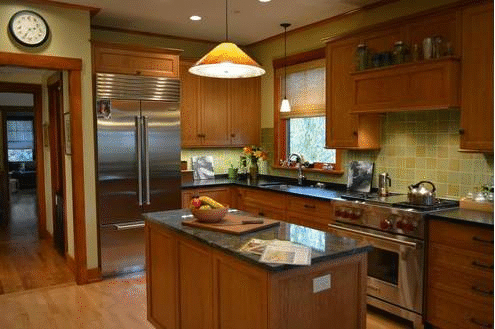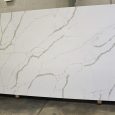Budgeting for a new kitchen or bath, even a modest-size one, is no small feat. It pays to approach the task armed with dollars and sense.
Updating your kitchen has long-term financial benefits. Experts say you can recoup 80 percent or more of the project’s cost when you sell your home. Yet, even if you’re not planning on moving a kitchen improvement can do much to improve your lifestyle.
If you’d like to make your space look and live better without spending more than you can afford, some cost-control basics are a good starting point as you plan your kitchen (or bath) project.
 |  |
Define the Scope of Your Project
How big is the project? Cosmetic changes will not fix old appliances, outdated cabinets, out-of-style surfaces, and design flaws. Yet, often a home’s structure and site make adding on, bumping out, or knocking down walls impractical or cost-prohibitive. If you don’t really need more square footage, it is usually possible to gut the room and work within its dimensions. Also, by limiting structural costs, you may choose to put more money into the items that will make your kitchen stand out.
Budget
Just as sticker shock afflicts new-car buyers, new-kitchen outfitters are at risk of appliance apoplexy and cabinetry coronaries. If the actual products are not very expensive enough, wait until you figure in labor, installation, and design costs.
For some items, such as cabinetry, flooring, tile, and plumbing fixtures, labor costs can equal or exceed the costs of the products or materials. It is also wise to allow a 10-20 percent cushion in the budget for unforeseen expenses. So, a $30,000 kitchen budget might contain as little as $10,000-$15,000 worth of products.
Set Priorities
Knowing what is important and what is not will help you make the most of your funds. Your general goals may include a lighter, brighter, more up-to-date kitchen that feels less cramped and fits a casual, family-centered lifestyle. You may want a gas range, a large sink with a pullout faucet, and easy-to-clean surfaces. Make a list of splurges as well: painted-wood cabinetry and hardwood flooring; granite countertops and glass-door cabinets
Get Professional Advice
Though the size and shape of your kitchen may stay the same, be open to layout changes that could improve its functionality. That calls for professional advice. Working with a designer is not inexpensive, but it can save money in the long run by helping avoid costly mistakes.
Local kitchen and bath showrooms may offer free initial design consultations where you can chat with a pro about the scope of your project, your budget, and priorities.
Next, set up an in-home consultation in which a designer looks at the space, takes detailed measurements, and has an in-depth discussion about your needs and wants. Inquire about the fees before committing to this step.
The next phase is design development, in which the designer fleshes out the initial concept into a detailed floor plan with product suggestions and specific costs. This typically costs 3-5 percent of the estimated budget.
If and when you approve a final plan, you’ll sign a contract that specifies agreed-upon products and installation labor, the payment schedule, and the anticipated starting and completion dates for the project.
A common payment arrangement is 50 percent down when the contract is signed, another 40 percent when the cabinets are delivered, and the balance upon completion of the project.
Explore All Product Sources
Some design firms also sell all the products and materials needed to complete a project. They may even require that you leave the buying to them. In other cases, you can shop on your own for some items, such as appliances.
Whether you work with a designer or not, it pays to shop around for kitchen products. There are more sources than ever and more possible variations in price and quality. Plus, the knowledge you pick up about features and price ranges will make you a more informed consumer if you choose to work with a designer.
You may prefer to shop for your own appliances, coordinating your selections with the designer. For initial research, focus on three sources: the Internet, national home-center chains, and local appliance dealers.
Manufacturers’ web sites are excellent for researching the various appliance features and comparing models. Online shopping sites allow price comparisons. Home centers are ideal for actually seeing the products you’ve researched on the Internet, with models from several manufacturers all in proximity.
When it comes time to buy, however, it may pay to deal with a local family-owned retailer with competitive prices, free delivery, special rebates, and a history in the community for good products and service.
Make Satisfying Substitutions
As you crunch numbers, you may face some tough choices. For example, to get certain storage options, you may need to step up from stock cabinetry to semicustom units. That, in turn, may mean forgoing a painted wood finish for a less-expensive finish and losing glass-front doors.
If professional-grade model stainless-steel appliances are out of your budget, you may want to sub in some less expensive, pro-look versions instead.
Is granite too pricey for your entire countertop? Consider using it on a focal point (such as an island or sink area), or go with granite tiles or economical stone-look laminate.
Is the fancy edgework that you would love to have on your granite top too expensive for your budget? Consult your kitchen top installer or designer, how to achieve the look you want by using simpler and less expensive edgework.
Is the stone you would love to use for your kitchen top killing your budget? Talk to the consultants at your stone supplier how to achieve the look you would like to have by using a less expensive option. Do not get married to a product that you cannot afford – ask about the relative price differences between various products, or select more than one option and ask your granite installer to price your project with your options in mind. Then when faced with the numbers decide where you can trade look for price.
Real hardwood flooring is beautiful, but pricey. Consider porcelain tiles or other less expensive options if necessary.
Beware the Bottom Line
Pay attention to the unexpected items, such as moving a gas line, replacing a window, or rewiring for additional lighting. All these are added expenses, yet the best time to do many of these is when the room is opened up and being renovated. Consider the ramification of each item before nixing it due to budget restraints.
More than anything, keep an open mind to your budget. Take this lesson to heart in calculating your kitchen costs, but don’t allow the bottom line to blind you blind to the overall picture. Do not you risk knowing the price of everything and the value of nothing. The ultimate value of what you are achieving with your remodel project should also factor in your considerations.








